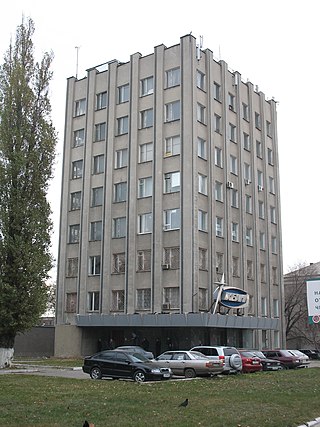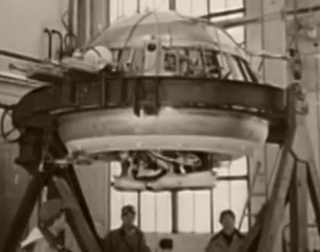Related Research Articles

Valentin Petrovich Glushko was a Soviet engineer of Ukrainian origin who was program manager of the Soviet space program from 1974 until 1989.
The highest specific impulse chemical rockets use liquid propellants. They can consist of a single chemical or a mix of two chemicals, called bipropellants. Bipropellants can further be divided into two categories; hypergolic propellants, which ignite when the fuel and oxidizer make contact, and non-hypergolic propellants which require an ignition source.

The staged combustion cycle is a power cycle of a bipropellant rocket engine. In the staged combustion cycle, propellant flows through multiple combustion chambers, and is thus combusted in stages. The main advantage relative to other rocket engine power cycles is high fuel efficiency, measured through specific impulse, while its main disadvantage is engineering complexity.
The RD-8 is a Soviet / Ukrainian liquid propellant rocket engine burning LOX and RG-1 in an oxidizer rich staged combustion cycle. It has a four combustion chambers that provide thrust vector control by gimbaling each of the nozzles in a single axis ±33°. It was designed in Dnipropetrovsk by the Yuzhnoye Design Bureau as the vernier thruster of the Zenit second stage. As such, it has always been paired with the RD-120 engine for main propulsion.

NPO Energomash “V. P. Glushko” is a major Russian rocket engine manufacturer. The company primarily develops and produces liquid propellant rocket engines. Energomash originates from the Soviet design bureau OKB-456, which was founded in 1946. NPO Energomash acquired its current name on May 15, 1991, in honor of its former chief designer Valentin Glushko.
RD-270 (Russian: Раке́тный дви́гатель 270, Rocket Engine 270, 8D420) was a single-chamber liquid-bipropellant rocket engine designed by Energomash (USSR) in 1960–1970. It was to be used on the first stages of proposed heavy-lift UR-700 and UR-900 rocket families, as well as on the N1. It has the highest thrust among single-chamber engines of the USSR, 640 metric tons at the surface of Earth. The propellants used are unsymmetrical dimethylhydrazine (UDMH) and nitrogen tetroxide (N2O4). The chamber pressure was among the highest considered, being about 26 MPa. This was achieved by applying full-flow staged combustion cycle for all the incoming mass of fuel, which is turned into a gas and passes through a couple of turbines before being burned in the combustion chamber. This allowed the engine to achieve a specific impulse of 301 s (2.95 km/s) at the Earth's surface.

The YF-100 is a Chinese liquid rocket engine burning LOX and kerosene in an oxidizer-rich staged combustion cycle.

Chemical Automatics Design Bureau (CADB), also KB Khimavtomatika, is a Russian design bureau founded by the NKAP in 1941 and led by Semyon Kosberg until his death in 1965. Its origin dates back to a 1940 Moscow carburetor factory, evacuated to Berdsk in 1941, and then relocated to Voronezh city in 1945, where it now operates. Originally designated OKB-296 and tasked to develop fuel equipment for aviation engines, it was redesignated OKB-154 in 1946.

The RD-0124 is a rocket engine burning liquid oxygen and kerosene in an oxygen-rich staged combustion cycle, developed by the Chemical Automatics Design Bureau in Voronezh. RD-0124 engines are used on the Soyuz-2.1b and Soyuz-2-1v. A variant of the engine, the RD-0124A, is used on the Angara rocket family's URM-2 upper stage.
The RD-120 is a liquid upper stage rocket engine burning RG-1 and LOX in an oxidizer rich staged combustion cycle with an O/F ratio of 2.6. It is used in the second stage of the Zenit family of launch vehicles. It has a single, fixed combustion chamber and thus on the Zenit it is paired with the RD-8 vernier engine. The engine was developed from 1976 to 1985 by NPO Energomash with V.P. Radovsky leading the development. It is manufactured by, among others, Yuzhmash in Ukraine.

Rocket propellant is the reaction mass of a rocket. This reaction mass is ejected at the highest achievable velocity from a rocket engine to produce thrust. The energy required can either come from the propellants themselves, as with a chemical rocket, or from an external source, as with ion engines.

Since the founding of SpaceX in 2002, the company has developed four families of rocket engines — Merlin, Kestrel, Draco and SuperDraco — and is currently developing another rocket engine: Raptor, and after 2020, a new line of methalox thrusters.

The SCE-200 is a 2 MN thrust class liquid rocket engine, being developed to power ISRO's existing LVM3 and upcoming heavy and super heavy-lift launch vehicles. It is being developed by Liquid Propulsion Systems Centre (LPSC) of ISRO and is expected to have first flight in 2020s.
The RD-843 is a Ukrainian single nozzle liquid propellant rocket engine burning pressure-fed UDMH and nitrogen tetroxide. It is rated for up to 5 restarts, and can gimbal up to 10 degrees in each direction.
The RD-861 is a Soviet liquid propellant rocket engine burning UDMH and nitrogen tetroxide in a gas generator combustion cycle. It has a main combustion chamber, with four vernier nozzles fed by the gas generator output. It can be reignited a single time.
The RD-855 (GRAU Index 8D68M]), also known as the RD-68M, is a liquid-fueled rocket engine with four nozzles. As a vernier engine, it provides fine steering adjustments for rockets. It is powered by a combination of N2O4, an oxidizer, and UDMH, a propellant. This combination is hypergolic, meaning the two substances ignite on contact, eliminating the need for an external ignition source.
The RD-856 (GRAU Index 8D69M), also known as the RD-69M, is a four-nozzle liquid-fuel rocket vernier engine, burning N2O4 and UDMH in a gas generator cycle. It was used on the R-36, Tsyklon-2 and Tsyklon-3 second stage as thrust vector control by gimbaling of its nozzle. The engine is distributed through a cylindrical structure that is integrated around the main engine RD-252 module. The structure includes aerodynamic protection for the nozzles. The engine was started by a pyrotechnic ignitor.
The RD-864 is a Soviet liquid propellant rocket engine burning UDMH and nitrogen tetroxide in a gas generator combustion cycle. It has a four combustion chambers that provide thrust vector control by gimbaling each nozzle in a single axis ±55°. It is used on the third stage of the R-36M UTTKh and Dnepr. For the R-36M2, an improved version, the RD-869 was developed.
The RD-801 is a Ukrainian liquid propellant rocket engine burning LOX and Kerosene (RG-1) in a staged combustion cycle. It has a single combustion chamber that provides thrust vector control by gimbaling of the nozzle in two axis by +/- 6°. It is being designed in Ukraine by Yuzhnoye Design Bureau for the prospective first stage propulsion of the Mayak rocket family.

Blok E is the propulsion unit of Soviet lunar module LK, developed in the 1960s by Yuzhnoye Design Bureau as a part of the human lunar landing program.
References
- ↑ Brügge, Norbert (2016-07-11). "Ukrainian space-rocket and missile liquid-propellant engines". B14643.de. Retrieved 2015-08-06.[ permanent dead link ]
- 1 2 3 Degtyarev, A . V.; Shulga, V . A.; Zhivotov, A . I.; Dibrivny, A . V. (2013). "СОЗДАНИЕ СЕМЕЙСТВА КИСЛОРОДНО-КЕРОСИНОВЫХ ЖИДКОСТНЫХ РАКЕТНЫХ ДВИГАТЕЛЕЙ НА БАЗЕ ОТРАБОТАННЫХ ТЕХНОЛОГИЙ ДЛЯ ПЕРСПЕКТИВНЫХ РАКЕТ-НОСИТЕЛЕЙ ГП "КБ "ЮЖНОЕ"" [THE DEVELOPMENT OF LOX - KEROSENE L IQUID ROCKET ENGINES FAMILY FOR PERSPECTIVE LAUNCH VEHICLES OF YUZHNOYE SDO BASED ON PROVEN TECHNOLOGIES](PDF). АВИАЦИОННО - КОСМИЧЕСКАЯ ТЕХНИКА И ТЕХНОЛОГИЯ (in Russian). National Aerospace university them. NE Zhukovsky. 2013 nr. 01 (98): 44–50. ISSN 1727-7337. Archived from the original (PDF) on 2016-08-16. Retrieved 2016-07-11.
- ↑ "RD-810". Defense Industry Of Ukraine Products And Services. Archived from the original on 2016-08-10. Retrieved 2016-07-11.
- 1 2 3 "RD-810". Yuzhnoye. Archived from the original on 2016-07-09. Retrieved 2016-07-11.
